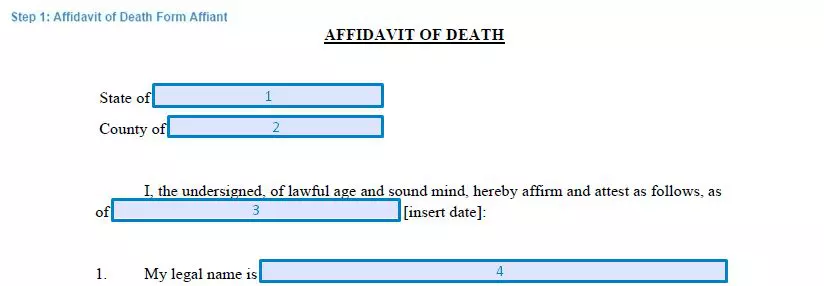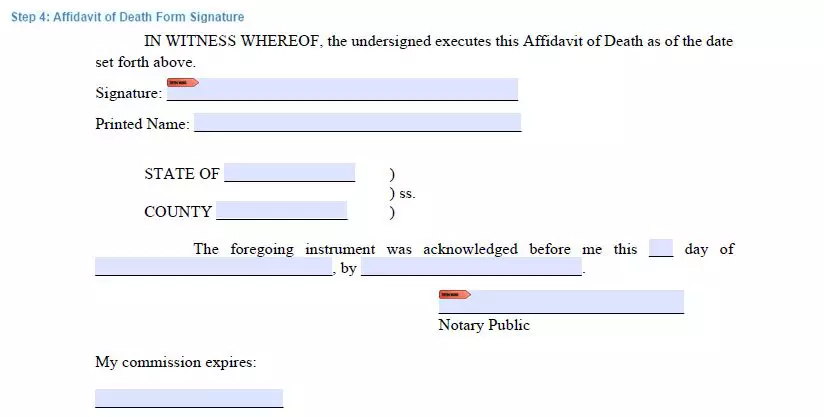Affidavit of Death
An affidavit of death is a document providing a sworn statement that someone has died. This legal form is completed when you need to notify a bank or insurance company about the person’s death. An affidavit of death is also applied to pass the decedent’s assets to the heirs or remove the title from joint bank accounts.
An affidavit of death can help when someone passes away intestate, that is, without leaving a will. In some states, this form is combined with an affidavit of heirship, allowing a legal heir or related beneficiary to claim the decedent’s estate without addressing probate court. Even if the deceased person leaves the last will, filing an affidavit of death will help you go to court and start the probate process immediately, not waiting weeks or months for the death certificate.
If you need to create an affidavit form, you are free to use our customizable template and add all the information related to your situation. Please take into account that you must notarize the affidavit and record the documents in the county office. Our guidelines below will help you prepare the affidavit as smoothly as possible.

Build Your Document
Answer a few simple questions to make your document in minutes
Save and Print
Save progress and finish on any device, download and print anytime
Sign and Use
Your valid, lawyer-approved document is ready
Here are some definitions that may be useful to know:
Affidavit – a legal document used to make a written statement, which is sworn under oath to be true.
Heirship – the legal right to inherit assets after someone related with you dies.
Beneficiary – a person named to receive property or other benefits from the decedent.
Probate court – a judicial system segment that takes care of a legal process in which the estate is administered and divided among the heirs and beneficiaries.
Transfers on death deed – legal documents that help arrange who will get the real property after the current owner dies. They usually turn real estate into a non-probate property.
Joint tenancy – refers to ownership of an equal share of the entire property.
When to Use an Affidavit of Death
Affidavit of death forms are useful when you need to prove someone’s death. Usually, these legal documents come in handy when necessary to transfer the title on the decedent’s property or other assets to the beneficiary. The most common situations are the following:
- You need to transfer assets to a surviving spouse.
An affidavit of death allows a surviving spouse to get the decedent’s property and access to the checking account, as well as remove the deceased’s name from joint credit cards or bank accounts. For the most part, it would be relevant if someone resided in the state with community property law and died without the last will. In this case, an affidavit of death of a spouse would provide the implicit transfer of assets to the surviving spouse.
- You need to transfer the property of a living trust.
A person uses a living trust to manage the estate while they are still alive and coordinate the estate distribution after they die. A married couple usually creates a living trust together, so both spouses are considered to be co-trustees. Therefore, if one of them dies, an affidavit of death of the trustee will pass the living trust property to the surviving trustee.
- You need to change the title of a joint tenancy.
When people decide to own the real property together, they agree to a joint tenancy. The parties are not exclusively a married couple—it can also be family members or close friends. In case one of the owners dies, an affidavit of death of joint tenant helps another owner to address the title company and change the title to the sole ownership of the property.
- You need to use a transfer on the death deed.
A transfer on a death deed, also known as a beneficiary deed, is a good way to avoid the probate process. It’s similar to the last will and helps transfer a person’s real estate after death to a beneficiary. However, unlike with the will, appointed beneficiaries can get their inheritance by only completing an affidavit of death of the grantor (deceased property owner). Note that this type of affidavits is applicable only in certain states. You are recommended to check the state law before filing the document.
What Information an Affidavit of Death Should Contain
As mentioned above, you can use an affidavit of death in different cases. Each of the documents requires specific components to include. For example, an affidavit of the death of a spouse may contain marriage details. Nevertheless, the following information has to be included no matter the situation.
Affiant. This section describes the person taking care of the document preparation, including the name and address. It can be a beneficiary to the decedent’s property, such as a family member or surviving spouse, or a third party. The affiant is expected to be of legal age and close to the decedent.
Decedent. The essential component is to provide the decedent’s name and when and where the decedent died. Depending on the affidavit type, you can also include other details, like joint property ownership or marriage information if you are the surviving spouse.
Legal description of the property. This part is included in affidavits used to transfer the decedent’s real estate or property title, like an affidavit of death of the joint tenant. If the estate owner signs the transfer on the death deed, you can search the description of the property there. You have to use a legal property description to define the parcel of land’s boundaries correctly.
Jurisdiction. It’s important to indicate where the affidavit is created and signed because different jurisdictions have their specific requirements regarding the forms and death certificates.
Notary. The affidavit of death must include a notary public signature and verification.
Proof of death. In order to get access to and manage the decedent’s assets, you need to attach to the forms acceptable proof that the decedent has passed away, such as a death certificate.

Filling Out the Affidavit of Death
The affidavit of death is a short but important document. It would help if you took care not to make any mistakes. Make sure that all the information provided in the form is accurate. You are free to obtain legal help and check the state law during the process. Please create your form following the next steps.
Step 1. Identify the affiant
As the affiant, you should provide your name and competence to fill in the affidavit, including your legal age and appropriate knowledge of the decedent.

Step 2. Provide the death details
The next step is to indicate the name of the decedent and the death date. You should also provide the place where the decedent passed away.

Step 3. Describe the property
You have to add a legal description of the property. Please take into account that it’s not a mailing or physical address. You should search this information in the deed record in the office where the real property is located.

Step 4. Sign the affidavit
The last step is to date, sign, and notarize the affidavit. If the affidavit is connected with the assets transferring or property title removal, the law requires you to file the created document in the county recorder’s office. Please attach the other relevant documents, like a certified copy of the death certificate, a copy of survivorship, or a transfer on the death deed.
